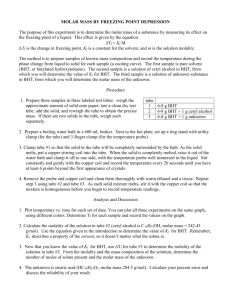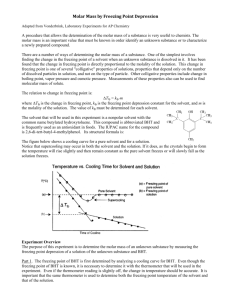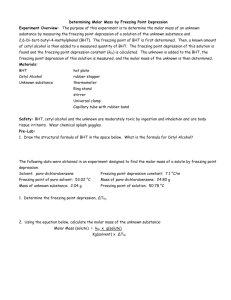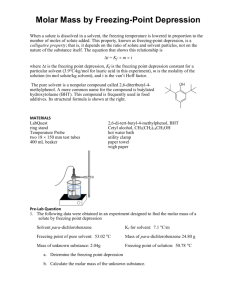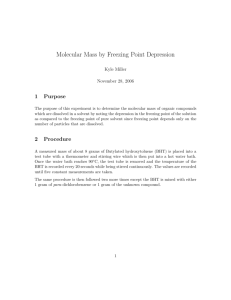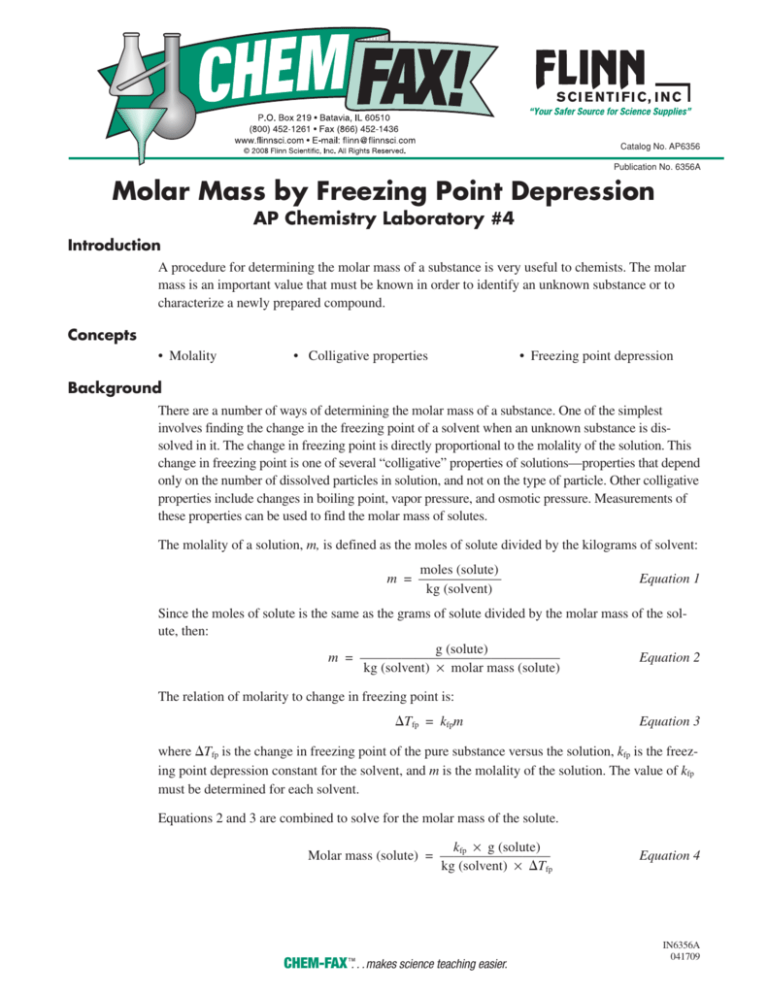
Catalog No. AP6356
Publication No. 6356A
Molar Mass by Freezing Point Depression
AP Chemistry Laboratory #4
Introduction
A procedure for determining the molar mass of a substance is very useful to chemists. The molar
mass is an important value that must be known in order to identify an unknown substance or to
characterize a newly prepared compound.
Concepts
• Molality
• Colligative properties
• Freezing point depression
Background
There are a number of ways of determining the molar mass of a substance. One of the simplest
involves finding the change in the freezing point of a solvent when an unknown substance is dissolved in it. The change in freezing point is directly proportional to the molality of the solution. This
change in freezing point is one of several “colligative” properties of solutions—properties that depend
only on the number of dissolved particles in solution, and not on the type of particle. Other colligative
properties include changes in boiling point, vapor pressure, and osmotic pressure. Measurements of
these properties can be used to find the molar mass of solutes.
The molality of a solution, m, is defined as the moles of solute divided by the kilograms of solvent:
moles (solute)
m = ——————
kg (solvent)
Equation 1
Since the moles of solute is the same as the grams of solute divided by the molar mass of the solute, then:
g (solute)
m = —————————–—————
Equation 2
kg (solvent) × molar mass (solute)
The relation of molarity to change in freezing point is:
⌬Tfp = kfpm
Equation 3
where ⌬Tfp is the change in freezing point of the pure substance versus the solution, kfp is the freezing point depression constant for the solvent, and m is the molality of the solution. The value of kfp
must be determined for each solvent.
Equations 2 and 3 are combined to solve for the molar mass of the solute.
kfp × g (solute)
Molar mass (solute) = ————————
kg (solvent) × ⌬Tfp
CHEM-FAX姠. . .makes science teaching easier.
Equation 4
IN6356A
041709
Molar Mass by Freezing Point Depression
Page 2
The solvent used in this experiment is a nonpolar solvent with the common name butylated
hydroxytoluene. This compound is abbreviated BHT and is frequently used as an antioxidant in
foods. The IUPAC name for the compound is 2,6-di-tert-butyl-4-methylphenol. Its structural formula is:
OH
(CH3)3C
C(CH3)3
CH3
The freezing point of BHT is approximately 70 °C. If the freezing points are determined for both
the solvent and the solution using a thermometer with minor scale divisions marked every 0.1 °C,
the freezing points can be estimated in the range: ±0.02 °C.
Figure 1 shows cooling curves obtained for both a pure solvent and for a solution. Notice that supercooling occurs in both the solvent and the solution. When supercooling occurs, the temperature falls
below the freezing point until the first crystal forms. The temperature then rises up and either stays
at the freezing point, in the case of the pure substance, or slowly falls as the solution freezes. The
freezing point temperature Tf of the solution is extrapolated from the graph.
Temperature vs. Cooling Time for Solvent and Solution
Ο
Ο
Ο
Pure Solvent
Ο
ΔTfp
Ο
Ο
Ο
Ο
Ο
Ο
Ο
Ο
(a) = Freezing point of
pure solvent
(b) = Freezing point of
solution
Supercooling
Solution
Time of Cooling
Figure 1. Freezing Point Graph for Pure Solvent and for Solution
Experiment Overview
The purpose of this experiment is to determine the molar mass of an unknown substance by measuring the freezing point depression of a solution of the unknown substance and BHT. The freezing point of BHT is first determined. Even though the freezing point of butylated hydroxytoluene
is known, it is necessary to determine it with the thermometer that is used in the experiment.
Thermometers can give temperature readings that are slightly different from true values. Even if
the thermometer reading is slightly off, the change in temperature should be accurate. It is important that the same thermometer is used to determine both the freezing point temperature of the solvent and that of the solution.
© 2009 Flinn Scientific, Inc. All Rights Reserved. Reproduction permission is granted only to science teachers who have purchased Molar Mass by Freezing Point Depression, Catalog No. AP6356,
from Flinn Scientific, Inc. No part of this material may be reproduced or transmitted in any form or by any means, electronic or mechanical, including, but not limited to photocopy, recording, or any
information storage and retrieval system, without permission in writing from Flinn Scientific, Inc.
Molar Mass by Freezing Point Depression
Page 3
A known amount of cetyl alcohol is then added to a measured quantity of BHT. The freezing point
depression of this solution is found and the freezing point depression constant (kfp) is calculated. The
unknown is added to BHT, the freezing point depression of this solution is measured, and the molar
mass of the unknown is then determined.
Pre-Lab Questions
1. The following data were obtained in an experiment designed to find the molar mass of a solute
by freezing point depression.
Solvent: para-dichlorobenzene
Freezing point depression constant: 7.1 °C/m
Freezing point of pure solvent: 53.02 °C
Mass of para-dichlorobenzene: 24.80 g
Mass of unknown substance: 2.04 g
Freezing point of solution: 50.78 °C
a. Determine the freezing point depression, ΔTfp.
b. Using Equation 4, calculate the molar mass of the unknown substance.
2. What are colligative properties?
Materials
2,6-Di-tert-butyl-4-methylphenol, BHT, 16 g
Balance (0.001 g precision)
Cetyl alcohol, CH3(CH2)14CH2OH, 1 g
Ring stand
Unknown substance, 1 g
Wire stirrer
Test tube, 18 × 150 mm
Weighing paper or dish
Beaker, 400-mL
Thermometer (preferably graduated to 0.1 °C)
Universal clamps, 2
Hot plate or Bunsen burner, ring clamp and
wire gauze with ceramic center
Split rubber stopper with one hole
Timer, seconds
Safety Precautions
2,6-Di-tert-butyl-4-methylphenol, BHT, is moderately toxic by ingestion and inhalation and is a
body tissue irritant. Cetyl alcohol and the unknown substance are slightly toxic by ingestion and
are body tissue irritants. Wear chemical splash goggles, chemical-resistant gloves, and a chemicalresistant apron. Wash hands thoroughly with soap and water before leaving the laboratory.
© 2009 Flinn Scientific, Inc. All Rights Reserved. Reproduction permission is granted only to science teachers who have purchased Molar Mass by Freezing Point Depression, Catalog No. AP6356,
from Flinn Scientific, Inc. No part of this material may be reproduced or transmitted in any form or by any means, electronic or mechanical, including, but not limited to photocopy, recording, or any
information storage and retrieval system, without permission in writing from Flinn Scientific, Inc.
Molar Mass by Freezing Point Depression
Page 4
Procedure
Thermometer
Split stopper
Stirrer
Water bath
Hot plate
Figure 2. Diagram of Apparatus for Freezing Point Determination
1. Assemble the apparatus as diagrammed in Figure 2. Do not add water to the beaker. Clamp the
thermometer using a split rubber stopper. Do not seal the test tube with the stopper—it is just
to support the thermometer. Make a stirrer out of wire bent with a circle at the bottom. The test
tube is clamped in the beaker so that the solid it contains will be below the level of the water in
the beaker. The beaker sits on a hot plate.
2. Disassemble the apparatus by sliding both the thermometer and stirring wire assembly and the
test tube clamp off the ring stand. Weigh the test tube on an analytical balance.
3. Accurately measure about 8 g of BHT into the test tube. Record the combined mass of the test
tube and the BHT in the Data Table.
4. Clamp the test tube in the beaker and insert the thermometer and stirring wire assembly into
the test tube and clamp the assembly. Do not force the thermometer into the solid—allow it to
sit on top of the solid. Add water to the beaker so that the solid in the test tube is well below
the level of the water.
5. Turn on the hot plate and heat the water bath to about 90 °C.
6. Allow the BHT in the test tube to melt.
7. When the temperature of the BHT is 80 °C or above, remove the thermometer and test tube
from the water bath. First, raise the thermometer clamp so that the thermometer bulb is slightly
higher than the height of the water bath beaker. Next, raise the test tube clamp so that the thermometer is still positioned correctly in the test tube and the test tube clears the water bath beaker. (See Figure 3.)
© 2009 Flinn Scientific, Inc. All Rights Reserved. Reproduction permission is granted only to science teachers who have purchased Molar Mass by Freezing Point Depression, Catalog No. AP6356,
from Flinn Scientific, Inc. No part of this material may be reproduced or transmitted in any form or by any means, electronic or mechanical, including, but not limited to photocopy, recording, or any
information storage and retrieval system, without permission in writing from Flinn Scientific, Inc.
Molar Mass by Freezing Point Depression
Page 5
Thermometer
Split stopper
Stirrer
Water bath
Hot plate
Figure 3.
8. Record the BHT temperature in the Cooling Data Table every 20 seconds as the melted BHT
cools. It is important to continuously stir the BHT to maintain even cooling. Stirring also helps
prevent supercooling. Stir until BHT solidifies.
9. Continue recording temperature values in the Cooling Data Table until at least five values are
constant. Make a note of the temperature at which crystals begin to form.
10. If instructed, repeat this measurement.
11. Using an analytical balance, accurately measure about 1 g of cetyl alcohol onto a piece of
waxed weighing paper and record its exact mass in the Data Table.
12. Place the cetyl alcohol into the test tube containing BHT.
13. Clamp the test tube in the water bath and insert the thermometer and stirring wire assembly
into the test tube (see Figure 2).
14. Heat the mixture in the hot water bath until the substances are all melted. Stir well to ensure
the solution is homogeneous.
15. When the solution temperature reaches 80 °C or higher, remove the test tube from the hot
water bath. Stir the solution and record the temperature every 20 seconds as the solution cools.
Record at least six temperature values after crystals first begin to form.
16. If instructed, repeat this measurement.
17. Repeat steps 1–3 and 11–15 using fresh BHT, a clean test tube, thermometer, stirrer, and about
1 g of the unknown compound in place of 1 g of cetyl alcohol. Repeat this measurement, if
instructed.
© 2009 Flinn Scientific, Inc. All Rights Reserved. Reproduction permission is granted only to science teachers who have purchased Molar Mass by Freezing Point Depression, Catalog No. AP6356,
from Flinn Scientific, Inc. No part of this material may be reproduced or transmitted in any form or by any means, electronic or mechanical, including, but not limited to photocopy, recording, or any
information storage and retrieval system, without permission in writing from Flinn Scientific, Inc.
Molar Mass by Freezing Point Depression
Page 6
Disposal and Cleanup
Your instructor will provide disposal and clean-up instructions.
Graph and Calculations
Graph the cooling data as shown in Figure 1.
From your graph, determine the freezing points of the solvent and each of the solutions, and the
values of ΔTfp. Calculate the freezing point depression constant from the molarity and ΔTfp of the
cetyl alcohol solution. Calculate the molar mass of the unknown solute using the freezing point
depression constant, the mass of the unknown solute, and the mass of BHT. Enter these values in
the Calculation Table.
Data Tables
Trial #1
Trial #2
Mass of empty test tube #1, g
Mass of test tube #1 plus BHT, g
Mass of BHT, g
Mass of weighing paper, g
Mass of weighing paper plus cetyl alcohol, g
Mass of cetyl alcohol, g
Mass of empty test tube #2, g
Mass of test tube #2 plus BHT, g
Mass of BHT, g
Mass of unknown, g
© 2009 Flinn Scientific, Inc. All Rights Reserved. Reproduction permission is granted only to science teachers who have purchased Molar Mass by Freezing Point Depression, Catalog No. AP6356,
from Flinn Scientific, Inc. No part of this material may be reproduced or transmitted in any form or by any means, electronic or mechanical, including, but not limited to photocopy, recording, or any
information storage and retrieval system, without permission in writing from Flinn Scientific, Inc.
Molar Mass by Freezing Point Depression
Page 7
Cooling Data Table
Temperature in °C
Time, in Seconds
Pure BHT
BHT + Cetyl Alcohol
BHT + Unknown
BHT
BHT + Cetyl Alcohol
BHT + Unknown
—
—
Calculation Table
Freezing Point, °C
ΔTfp, °C
—
kfp, °C/m
Molar mass, g/mole
—
—
% error, molar mass
—
—
© 2009 Flinn Scientific, Inc. All Rights Reserved. Reproduction permission is granted only to science teachers who have purchased Molar Mass by Freezing Point Depression, Catalog No. AP6356,
from Flinn Scientific, Inc. No part of this material may be reproduced or transmitted in any form or by any means, electronic or mechanical, including, but not limited to photocopy, recording, or any
information storage and retrieval system, without permission in writing from Flinn Scientific, Inc.
Molar Mass by Freezing Point Depression
Page 8
Post-Lab Questions (Show all work on a separate sheet of paper.)
1. The following errors occurred when the above experiment was carried out. How would each
affect the calculated molar mass of the solute (too high, too low, no effect)? Explain your
answers.
a. The thermometer used actually read 1.4 °C too high.
b. Some of the solvent was spilled before the solute was added.
c. Some of the solute was spilled after it was weighed and before it was added to the solvent.
d. Some of the solution was spilled after the solute and solvent were mixed but before the
freezing point was determined.
2. What was the least precise measurement in the experiment? How does this limit your significant digits?
3. Did the solutions show any evidence of supercooling?
4. Why is it advantageous to choose a solvent that has a large value for Kfp?
5. Explain why the pure solvent shows a level horizontal curve as solidification occurs, but the
curve for the solution slopes downward slightly.
Alternative Microscale Procedure
Equipment
2, 6-Di-tert-butyl-4-methylphenol, BHT, 1 g
Capillary tubes
Cetyl alcohol, CH3(CH2)14CH2OH, 0.1 g
Cork or split rubber stopper
Unknown substance, 0.1 g
Balance (0.001 g precision)
Beaker, 10-mL or 50-mL
Small rubber band
Beaker, 250-mL, or Thiele melting point tube
Stirring rod
Bunsen burner or hot plate, ring stand,
ring clamp, wire gauze with
ceramic center
Thermometer with 0.1 °C divisions
Universal clamp
Mortar and pestle or watch glass and test tube
Procedure
1. Pulverize a small amount (about 0.5 g) of BHT. Use a mortar and pestle, or use a watch glass
and the bottom of a test tube.
2. Pack the BHT in a capillary tube to a depth of about 1 cm. To get the BHT into the capillary
tube, push the open end of the capillary tube down into a small pile of BHT powder. Turn the
tube so the open end is up, and bounce the bottom of the tube on the desk top. The BHT may
also be packed by holding a long piece of 6 mm diameter glass tubing (1 m in length) upright
on the floor, and dropping the capillary tube down the glass tubing so it bounces up and down
a few times.
3. Obtain a small rubber band, and use it to fasten the capillary tube to a thermometer. The BHT
should be level with the bulb of the thermometer.
4. Use a universal clamp and split rubber stopper to fasten the thermometer to a ring stand.
© 2009 Flinn Scientific, Inc. All Rights Reserved. Reproduction permission is granted only to science teachers who have purchased Molar Mass by Freezing Point Depression, Catalog No. AP6356,
from Flinn Scientific, Inc. No part of this material may be reproduced or transmitted in any form or by any means, electronic or mechanical, including, but not limited to photocopy, recording, or any
information storage and retrieval system, without permission in writing from Flinn Scientific, Inc.
Molar Mass by Freezing Point Depression
Page 9
5. Immerse the bottom of the capillary and thermometer in a beaker of water (or a Thiele melting
point tube filled with water) and heat (see Figure 4).
Notched Stopper
Thermometer
Clamps
Notched Stopper
Clamp
Thermometer
Rubber band
Capillary
tube
Water level
Rubber band
Water level
Capillary tube
Thiele tube
Beaker
Ring stand
Ring stand
Bunsen burner
Hot plate
Figure 4.
6. If using a beaker, stir the water to maintain an even distribution of temperature. Heating can be
rapid in the beginning, but as the temperature approaches the melting point, ≈ 67 °C, heat very
slowly in order to get an accurate value.
7. Record the temperature at which the BHT melts (the white powder will become clear) in the
Data Table. If repeating the melting procedure, use a new sample and capillary tube.
8. Use an analytical balance to accurately measure about 0.5 g BHT into a small beaker. Record
the mass in the Data Table.
9. Accurately measure about 0.1 g cetyl alcohol into the beaker. Record the mass in the Data
Table.
10. Heat the beaker gently over a small flame or on a hot plate.
11. When the substance melts, mix it well with a stirring rod until it is homogeneous.
12. Allow the mixture to cool and solidify.
13. After it solidifies, pulverize a small amount of the mixture. Repeat steps 2–7 to determine the
solution melting point.
14. Repeat steps 8–13 using 0.5 g of BHT and 0.1 g of the unknown substance.
Calculations
Determine ΔTfp for the solution of cetyl alcohol and of the unknown substance in BHT. Calculate
the molality of the cetyl alcohol solution and use it to determine the value of the freezing point
depression constant, kfp, for BHT. Use the calculated value of kfp, along with the masses of the
unknown solute and BHT, to find the molar mass of the unknown solute.
© 2009 Flinn Scientific, Inc. All Rights Reserved. Reproduction permission is granted only to science teachers who have purchased Molar Mass by Freezing Point Depression, Catalog No. AP6356,
from Flinn Scientific, Inc. No part of this material may be reproduced or transmitted in any form or by any means, electronic or mechanical, including, but not limited to photocopy, recording, or any
information storage and retrieval system, without permission in writing from Flinn Scientific, Inc.
Molar Mass by Freezing Point Depression
Page 10
Data Tables. Microscale Procedure
Melting Points
Pure BHT
°C
BHT + cetyl alcohol
°C
BHT + unknown
°C
Masses
BHT
Cetyl Alcohol
Solution #1 — BHT + Cetyl Alcohol, g
Unknown
—
Solution #2 — BHT + Unknown, g
—
Calculations
kfp, BHT, °C/m
__________ °C/m
Molar mass, unknown, g/mole
__________ g/mole
© 2009 Flinn Scientific, Inc. All Rights Reserved. Reproduction permission is granted only to science teachers who have purchased Molar Mass by Freezing Point Depression, Catalog No. AP6356,
from Flinn Scientific, Inc. No part of this material may be reproduced or transmitted in any form or by any means, electronic or mechanical, including, but not limited to photocopy, recording, or any
information storage and retrieval system, without permission in writing from Flinn Scientific, Inc.


